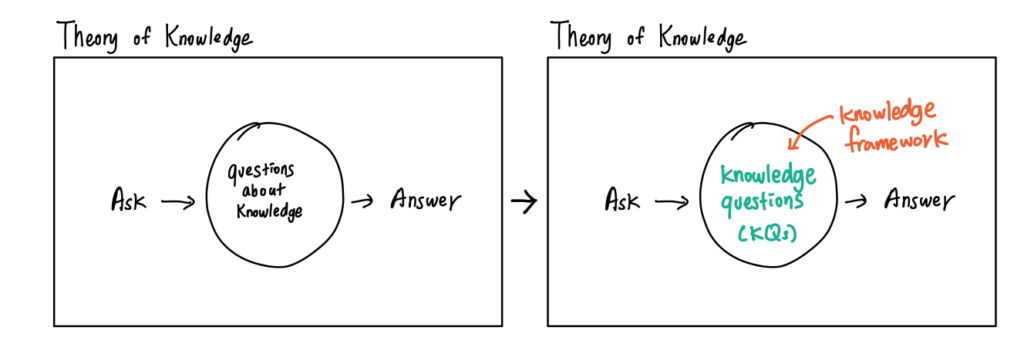*This article is part of the TOK Roadmap — a visual, all-in-one guide I created to help you ace Theory of Knowledge. [View the full roadmap here.]
In this post, I explain
- What are Knowledge Questions (KQs)?
- Core Theme and Optional Themes (quick tip: don’t stress about them unless required by your teacher)
TL;DR: Understand that you answer a ‘knowledge question’ in TOK Exhibition, and that you can skip IB’s recommendation to follow core/optional themes, unless it’s required by your teacher.
Knowledge Questions (KQs)
If you want, I explain KQs in detail in this post.
Before you start your TOK exhibition, I want to explain the concept of Knowledge Questions (KQs), because they’re really the foundation of TOK.
I said before that TOK is a class about asking and answering open-ended questions about knowledge. ‘Knowledge questions’ is just a formal way of saying it defined under what’s called the ‘knowledge framework’

Knowledge framework presents four ways to categorize a KQ:
- Scope: how do you define knowledge?
- Perspectives: how do you perceive knowledge?
- Methods and Tools: how do you create knowledge?
- Ethics: how do you evaluate knowledge?
TOK Exhibition is an essay where you answer one of these questions using three real-world objects.
Depending on which question you choose (see the 35 prompts here), you may talk about ethics of knowledge, how culture affects how we learn knowledge, etc.
Try to spot these categories in the prompts:
- “16. Should some knowledge not be sought on ethical grounds?” –> it’s clearly about how we evaluate knowledge (Category 4), making judgements on good/bad/it depends.
- “11. Can new knowledge change established values or beliefs?” –> it’s about how we perceive knowledge (Category 2), because as humans, we have different attitudes to what we encounter based on our values and beliefs.
- Some questions are a bit more nuanced like “29. Who owns knowledge?” Honestly, you can approach it with multiple categories here.
Don’t let the fact that you’re answering a KQ intimidate you. As I’ll explain later, just like in any essay writing class, the key is choosing a good argument (object in this case) –> finding good evidence –> and writing a coherent paragraph.
Core Theme and Optional Themes
*If you’d like, you can read a more detailed post about these themes here.
IB strongly recommends you to “base your Exhibition in one of the TOK themes—either the core theme or one of the optional themes.” This is to give you an approachable starting point when searching for good objects….
You can ignore this (unless your teacher requires it)—because what the rubric demands is 1) good objects 2) clear explanations of their link to the prompt with evidence. That’s it. Your ability to include TOK themes and terms is a nice bonus, but not the main deal.
The core and 5 optional themes are:
- Knowledge and the Knower (core), then
- Knowledge and Technology,
- Knowledge and Language,
- Knowledge and Politics,
- Knowledge and Religion,
- Knowledge and Indigenous Societies.
These are simply areas of exploration that you might look into when searching for real-world objects. It doesn’t mean you have to choose one theme and have all three objects fit into that theme—this is not specified in the rubric.
The only exception I can think of is when teachers require you to choose a theme—in this case, because the exhibition is graded by your teacher, it’s best to follow it.
Later, I’ll write about these individual themes to help you explore, but this is not a must-read to do well.
Updated: April 9, 2025

Leave a Reply